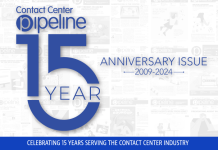
The expression “take a bow” is defined by the Merriam-Webster Dictionary as “to bow toward an audience that is applauding. It is often used figuratively to say that someone deserves to be praised.” Much as I would like to propose an actual round of applause on the contact center floor, I’m not sure that would be appropriate. However, I have found many sound effects apps that play an applause and I must say that they lighten me up a bit. You may want to download one and play an applause for your team members who have earned the opportunity to TAKE A BOW. It will be fun.
I think this concept has a lot of potential. The sound effects and graphics are all easy to acquire and people are generally happy when they are in a position to take a bow. So why not incorporate the concept into “praise plans” within a contact center “Take a Bow” program?
Is Praise a Problem?
Some cynics see praise as a crippling element within whatever generation they feel deserves criticism. I am pretty sure that cynics in every generation have taken aim at those that came later for having an easier time at life than they had. For example, Socrates (470 B.C.–399 B.C.), the ancient Greek philosopher, said, “Children now love luxury; they have bad manners, contempt for authority; they show disrespect for elders and love chatter in place of exercise. Children are now tyrants, not the servants of their households.”
Cynics seem to have demonized praise as the culprit to the spoiled and lazy offspring of the generation they have chosen to resent. I personally don’t see it that way. Spoiled brats have been on the planet since the beginning of time; making negative assumptions about people within a particular generation is a limiting and destructive force. Sadly, some contact center leaders withhold praise as a strategy… a mind-numbing belief as well as a genuinely bad idea. Withholding praise by default creates a focus on negative feedback, corrective action, and ultimately, low morale.
Praise as a Strategy
Praise as a strategy might scare some people and maybe it should. Praise must be authentic. Disingenuous and contrived praise is worse than negative feedback and is, in fact, downright creepy. The first step in the Take a Bow program is to assess your own relationship as a leader with offering praise. What is your current relationship with praise? Be honest… if your first instinct is that praise spoils, you have identified the first obstacle. Challenge that belief by documenting the evidence you have to support it. Think about what it is you tell yourself, for example, “Praise just makes people feel entitled.” If you listen carefully to yourself, you may find that your belief statements include your own resentments: “I never got praise and look how well I turned out!” or “Why should I praise someone for doing the job they are supposed to do?” Hearing thoughts like these inside your head is a siren call. A belief supported by resentments is powerful and often damaging in the long run. We all must challenge beliefs that don’t support our desired outcomes.
Praise as a strategy produces a cultural effect with outcomes in key areas such as a happier and more engaged workforce, higher productivity, fewer errors, and improved morale and retention. All these factors combine to deliver on the branded customer experience.
Dependencies
Take a Bow is an easy and cost-free way of creating a culture of praise and boasting feelings of worthiness. These efforts contribute to employee engagement and show appreciation for the workforce… be it the team, an individual, and yes, management. But there are dependencies. We have already addressed the impact of personal belief systems. Now let’s look at cultural and organizational requirements.
Contact center culture is an outcome, not a plan. Culture occurs as a result of actions… not posters, slogans, promises or innuendos. One thing we can comfortably assume is that most of the contact center workforce has the ability to recognize the disingenuous nature of a “culture campaign.” I honestly find the folks that plaster values posters and word clouds all over a building while providing crappy training, ancient chairs, poor lighting, not so pristine bathrooms, inadequate job aids, and a plethora of production metrics to be the most delusional.
The culture in these environments, at least in my experience, rarely includes praise as a strategy. It is more likely that they are too busy dealing with the outcome of their actual abusive culture, including high turnover rates (both front line and management), consistent absenteeism, tons of FMLA, tardiness, high error rates, and trying to address problems by blaming the front line. These anti-praise organizations are also anti-reward. Even the thought of providing lunch or even a gift card reward is met with a resounding “No way.” Culture is the first and most significant dependency. Be honest in your self-assessment and craft a change plan that focuses on action rather than testimony.
What Can We Do Now?
Work with a cross-functional team to craft your Take a Bow program. Arrange bulletin boards, virtually and on walls where staff can make nominations for any number of reasons. Here are a few examples. Take a bow…
- Helpful Colleague—A peer helps you out, swaps a shift with you, offers special words of kindness… Let’s hear a round of applause!
- Learning Moments and Mentoring—Someone has really helped out the team, mentored a new colleague, simplified a complicated process, helped with a tough new initiative… Let’s hear a round of applause!
- Party Planner—A management team supports monthly birthday celebrations, creates a Hobby Day so all can learn more about one another, hosts events like Hawaiian shirt day or dressing in the colors of a favorite sports team just for fun (a contact center I know hosted a hysterical Dress for Prom event)… Let’s hear a round of applause!
- Process Performance—A frontline team points out poor processes and recommends efficient solutions that will improve the daily workflow… Let’s hear a round of applause!
- Hosting Guests—Management decides to voluntarily establish and host a visitor’s cube equipped with a guest headset, a chair, and a guestbook in which visitors can sign in/out and leave comments after listening to live calls… Let’s hear a round of applause!
- Job Aids—Frontline staff recommend improvements/additions to job aids and reference tools that support them both on and off the phone. (Those closest to the tasks often have the best ideas for designing support material. Tap into this talent and recognize the contribution)… Let’s hear a round of applause!
Praise for Showing Up
How about praising frontline staff for actually showing up to work? I know this really riles the people who don’t believe in praise because it is the agent’s JOB to show up. I get that. But it shouldn’t disqualify the fact that on-time arrival, schedule adherence and quality are among the most fundamental requisites in any contact center. So why not recognize and praise those who consistently contribute in these categories? Take a bow! To learn more on this subject, read “Contribution to Capacity”… A Transformational Term” (May 2016) on the PowerHouse website.
The Power of Thank You
Say thank you for anything and everything! It is widely known that recognition from leaders and peers is tops when it comes to positive motivation. Thank you’s can be done in person, in public and in private… it all counts. In person is the most powerful, while public recognition lends another positive dimension. Take a bow!
A disadvantage of a public thank you to one team member is that it can exclude another who contributed equally to the project or activity. I have seen this happen; it takes a worthy action and sullies it with what amounts to or feels like a passive aggressive act. Leaders that do this should be ashamed, but often lack the self-reflection to see the conflict. This example points out the delicate nature of praise and its abuse when weaponized to inflict praise on one and pain on another. Generally speaking, the folks caught in this crossfire find themselves looking for a new job. In this market, they will likely find one!
In closing, remember to celebrate your management team! If this article ever reaches the executive level, give this team a round of applause for all the hard work and effort put into taking care of the business of the customer experience. Take a bow!



